Elon Musk unveils the Robovan: the biggest surprise from Tesla's We, Robot event
Rebecca Bellan and Maxwell Zeff
Thu, October 10, 2024
Elon Musk unveiled a prototype of Tesla's Robovan on Thursday night during the company's We, Robot event in Los Angeles. The Robovan will be an electric, autonomous vehicle roughly the size of a bus, designed for transporting people around high density areas. It will carry up to 20 people at a time and also transport goods, according to Musk.
"We're going to make this, and it's going to look like that," said Musk on Thursday night as the Robovan rolled towards center stage. That's about as much as Musk was willing to say, and we're not even sure that much is true.
Musk didn’t mention how much the Robovan would cost, how Tesla would produce it, or when it will come out. However, it does look pretty cool.
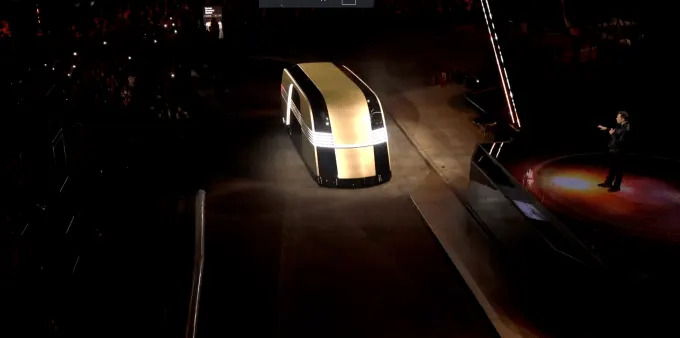 Elon Musk unveiling the Robovan at Tesla's We, Robot event. (Image credit: Tesla)Image Credits:Tesla
Elon Musk unveiling the Robovan at Tesla's We, Robot event. (Image credit: Tesla)Image Credits:Tesla
The Robovan has a retro-futuristic look – somewhere between a bus from The Jetsons and a toaster from the 1950s. It features silver metallic sides with black details, and strips of light running parallel to the ground along its sides, with doors that slide out from the middle. Inside, there are seats and room to stand, with tinted windows throughout. There is no steering wheel, since it’s autonomous.
"One of the things we want to do – and we've done this with the Cybertruck – is we want to change the look of the roads," said Musk. "The future should look like the future," he said, repeating an old line.
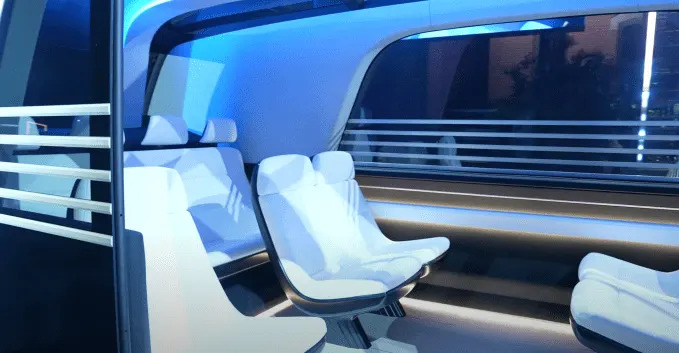
Rebecca Bellan and Maxwell Zeff
Thu, October 10, 2024
Elon Musk unveiled a prototype of Tesla's Robovan on Thursday night during the company's We, Robot event in Los Angeles. The Robovan will be an electric, autonomous vehicle roughly the size of a bus, designed for transporting people around high density areas. It will carry up to 20 people at a time and also transport goods, according to Musk.
"We're going to make this, and it's going to look like that," said Musk on Thursday night as the Robovan rolled towards center stage. That's about as much as Musk was willing to say, and we're not even sure that much is true.
Musk didn’t mention how much the Robovan would cost, how Tesla would produce it, or when it will come out. However, it does look pretty cool.
 Elon Musk unveiling the Robovan at Tesla's We, Robot event. (Image credit: Tesla)Image Credits:Tesla
Elon Musk unveiling the Robovan at Tesla's We, Robot event. (Image credit: Tesla)Image Credits:TeslaThe Robovan has a retro-futuristic look – somewhere between a bus from The Jetsons and a toaster from the 1950s. It features silver metallic sides with black details, and strips of light running parallel to the ground along its sides, with doors that slide out from the middle. Inside, there are seats and room to stand, with tinted windows throughout. There is no steering wheel, since it’s autonomous.
"One of the things we want to do – and we've done this with the Cybertruck – is we want to change the look of the roads," said Musk. "The future should look like the future," he said, repeating an old line.

The inside of the Robovan prototype. (Image credit: Tesla)
It looks similar to other purpose-built robotaxis, like those designed by Zoox and Cruise. Only Tesla’s van is much bigger. In China, WeRide has built a similar Robobus.
That said, the Robovan showed on Thursday is only a prototype. Despite what Musk says, there's no telling what the real thing will look like or when it will actually come out.
Tesla had kept the design of the vehicles it introduced on Thursday pretty close to the chest. The only real hint we had was from Tesla’s 2023 Investor Day, when the automaker teased a couple of new vehicles that appeared to be designed for volume production: One smaller vehicle that appears now to be the Cybercab, and a larger one that we can now say is likely the Robovan.
The stated goal at the time was to produce 20 million vehicles per year by 2030. That would mean that Tesla needs to increase production and sales by about 15 times from 2022.
During Thursday’s event, Musk did not outline any plans for building new production facilities or retooling existing facilities to accommodate either the Cybercab or the Robovan. He also didn’t provide much in the way of timelines for the Robovan, though he predicted the Cybercab would start production in 2026 or 2027.
It looks similar to other purpose-built robotaxis, like those designed by Zoox and Cruise. Only Tesla’s van is much bigger. In China, WeRide has built a similar Robobus.
That said, the Robovan showed on Thursday is only a prototype. Despite what Musk says, there's no telling what the real thing will look like or when it will actually come out.
Tesla had kept the design of the vehicles it introduced on Thursday pretty close to the chest. The only real hint we had was from Tesla’s 2023 Investor Day, when the automaker teased a couple of new vehicles that appeared to be designed for volume production: One smaller vehicle that appears now to be the Cybercab, and a larger one that we can now say is likely the Robovan.
The stated goal at the time was to produce 20 million vehicles per year by 2030. That would mean that Tesla needs to increase production and sales by about 15 times from 2022.
During Thursday’s event, Musk did not outline any plans for building new production facilities or retooling existing facilities to accommodate either the Cybercab or the Robovan. He also didn’t provide much in the way of timelines for the Robovan, though he predicted the Cybercab would start production in 2026 or 2027.
Tesla's Cybercab robotaxi is finally here, with a $30K price tag — plus a surprise Robovan

Pras Subramanian · Senior Reporter
Fri, October 11, 2024
Tesla (TSLA) and its CEO Elon Musk finally revealed the electric vehicle maker's long-awaited driverless robotaxi on Thursday night, alongside a surprise — a larger autonomous Robovan designed to transport a lot more people.
After a nearly one-hour delay, attendees at the “We, Robot” event in Los Angeles were given an up-close introduction to two of Tesla's latest creations, a key strategic focus for the EV pioneer.
Musk arrived via the robotaxi — dubbed "Cybercab" — which featured a Cybertruck-like light bar in the front, an small angular profile, scissor-like doors, and a minimalist interior. The Cybercab appeared to navigate the Warner Brothers Studios closed-course lot on the way to the event stage.
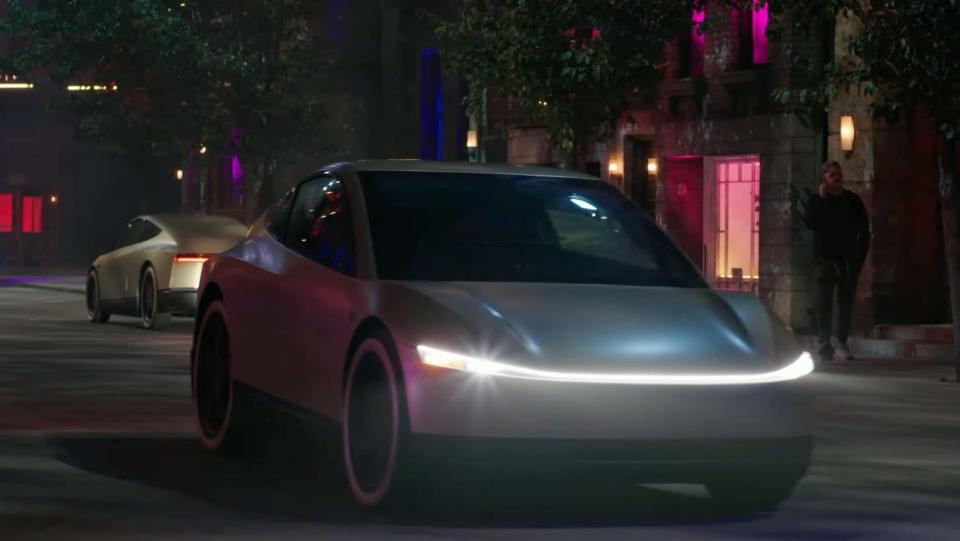
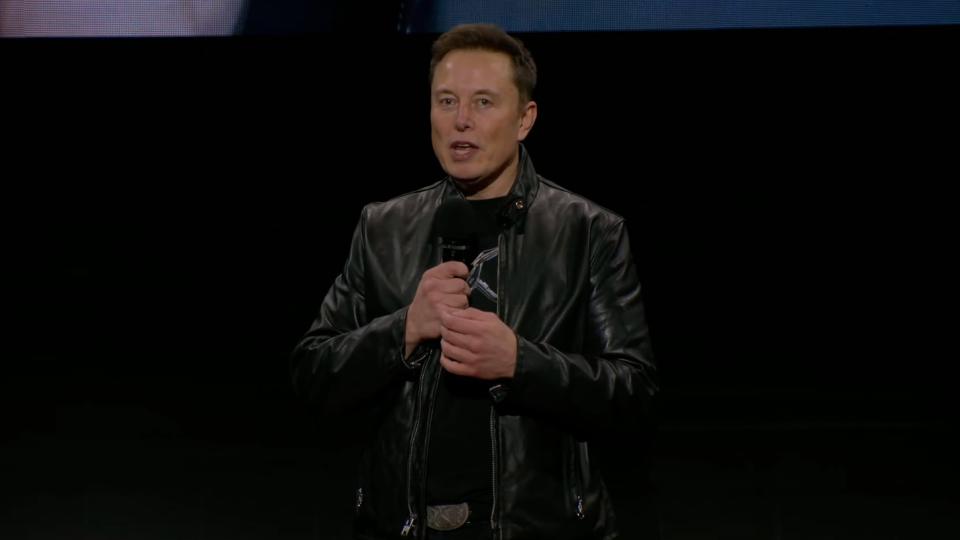
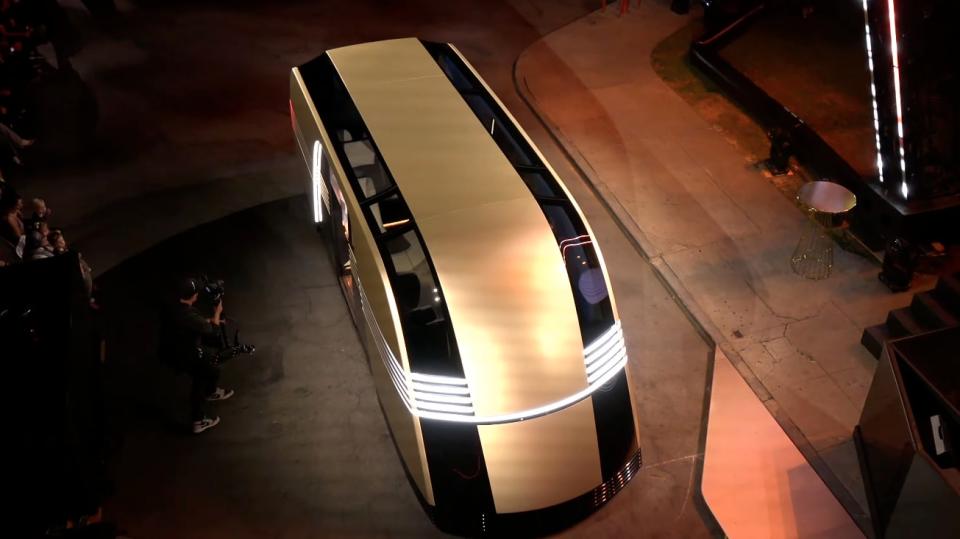
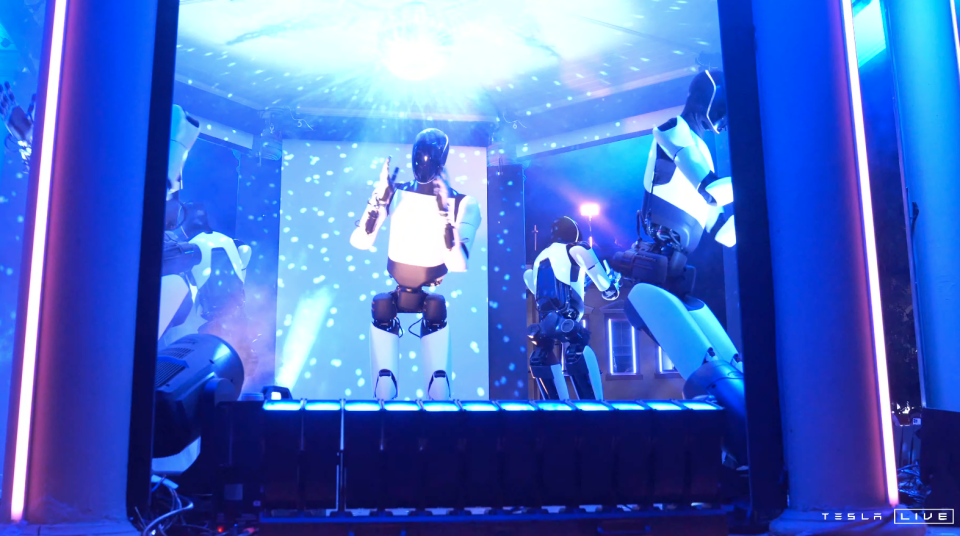

Pras Subramanian · Senior Reporter
Fri, October 11, 2024
Tesla (TSLA) and its CEO Elon Musk finally revealed the electric vehicle maker's long-awaited driverless robotaxi on Thursday night, alongside a surprise — a larger autonomous Robovan designed to transport a lot more people.
After a nearly one-hour delay, attendees at the “We, Robot” event in Los Angeles were given an up-close introduction to two of Tesla's latest creations, a key strategic focus for the EV pioneer.
Musk arrived via the robotaxi — dubbed "Cybercab" — which featured a Cybertruck-like light bar in the front, an small angular profile, scissor-like doors, and a minimalist interior. The Cybercab appeared to navigate the Warner Brothers Studios closed-course lot on the way to the event stage.
The Tesla Cybercab robotaxi (credit: Tesla) · Tesla
As expected, the Cybercab features no steering wheels or pedals, so is designed to be fully autonomous.
“We’ll move from supervised full self-driving, to unsupervised full self-driving,” Musk said, meaning the cars using this latest software will no longer need humans to interact if need be.
Musk said he expects the small EV to cost less than $30,000 when it arrives some time in 2026, but before 2027. The Cybercab will charge up via wireless induction technology, possibly using mats or tracks on roads.
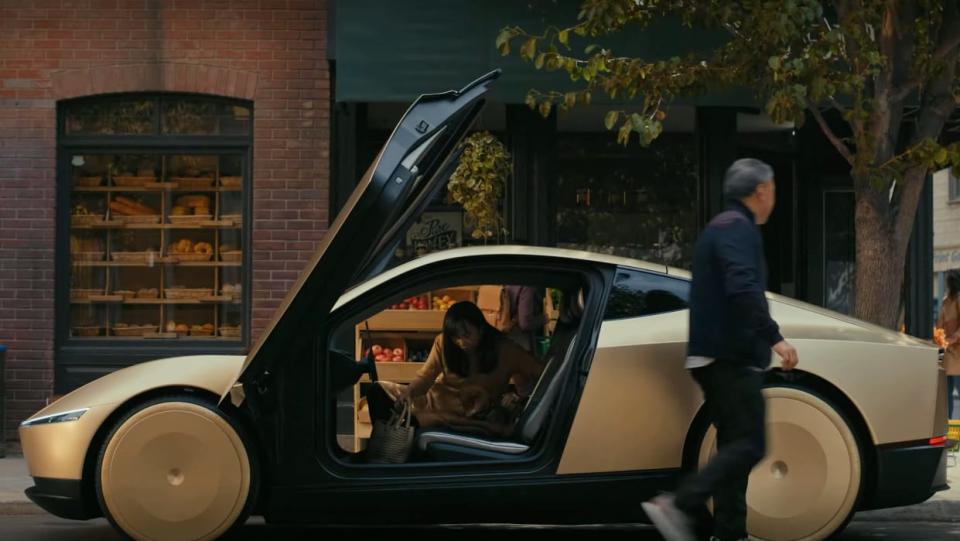 A Tesla Cybercab robotaxi (credit: Tesla) · Tesla
A Tesla Cybercab robotaxi (credit: Tesla) · Tesla
Tesla will start unsupervised full self-driving (FSD) trials in Texas and California next year, with Model 3 and Model Y test vehicles. Musk said further unsupervised FSD trials will take place wherever regulators allow them.
Wall Street analysts envision owners of the existing fleet of Teslas out on the road will be able to put those models on the company's rideshare service, once the EVs are combined with FSD and Tesla’s upcoming rideshare mobility app. That would unlock a tremendous amount of value and would be a true game-changer, the analysts believe.
As expected, the Cybercab features no steering wheels or pedals, so is designed to be fully autonomous.
“We’ll move from supervised full self-driving, to unsupervised full self-driving,” Musk said, meaning the cars using this latest software will no longer need humans to interact if need be.
Musk said he expects the small EV to cost less than $30,000 when it arrives some time in 2026, but before 2027. The Cybercab will charge up via wireless induction technology, possibly using mats or tracks on roads.
Tesla will start unsupervised full self-driving (FSD) trials in Texas and California next year, with Model 3 and Model Y test vehicles. Musk said further unsupervised FSD trials will take place wherever regulators allow them.
Wall Street analysts envision owners of the existing fleet of Teslas out on the road will be able to put those models on the company's rideshare service, once the EVs are combined with FSD and Tesla’s upcoming rideshare mobility app. That would unlock a tremendous amount of value and would be a true game-changer, the analysts believe.
Elon Musk at the "We, Robot" event (credit: Tesla) · Tesla
Tesla did not reveal its upcoming lower-cost “next-gen” model, which many analysts had expected. Though it is possible the Cybercab is essentially sharing the same chassis as the new passenger vehicle, as the car maker has suggested in the past. The sub-$30K next-gen EV will arrive later this year, Tesla has previously confirmed.
Surprise reveal
In an unexpected move, Tesla debuted the Robovan — a much larger EV with hidden wheels and no real windshield. The Robovan's design had echoes of the science-fiction movie Blade Runner, with wide light bars across the front facade and monolithic design. Musk said the Robovan is designed to transport up to 20 people, or a large amount of cargo, and can be adapted for commercial or personal use, according to Tesla.
No date of service or pricing was given for the Robovan.
Tesla did not reveal its upcoming lower-cost “next-gen” model, which many analysts had expected. Though it is possible the Cybercab is essentially sharing the same chassis as the new passenger vehicle, as the car maker has suggested in the past. The sub-$30K next-gen EV will arrive later this year, Tesla has previously confirmed.
Surprise reveal
In an unexpected move, Tesla debuted the Robovan — a much larger EV with hidden wheels and no real windshield. The Robovan's design had echoes of the science-fiction movie Blade Runner, with wide light bars across the front facade and monolithic design. Musk said the Robovan is designed to transport up to 20 people, or a large amount of cargo, and can be adapted for commercial or personal use, according to Tesla.
No date of service or pricing was given for the Robovan.
The Tesla Robovan EV (credit: Tesla) · Tesla
Finally Musk brought out a group of Optimus robots, walking on their own into the event space. Musk said the robots would likely cost between $20,000 and $30,000 when they eventually go on sale years from now — a claim he has made in the past.
Musk said the robots would mingle with attendees at the event, and even serve drinks to them at the bar.
In addition to interacting to the robots, attendees were offered rides in the Cybercabs and Model 3 and Model Y EVs operating autonomously.
Finally Musk brought out a group of Optimus robots, walking on their own into the event space. Musk said the robots would likely cost between $20,000 and $30,000 when they eventually go on sale years from now — a claim he has made in the past.
Musk said the robots would mingle with attendees at the event, and even serve drinks to them at the bar.
In addition to interacting to the robots, attendees were offered rides in the Cybercabs and Model 3 and Model Y EVs operating autonomously.
Optimus robots dancing at the "We, Robot" event (credit: Tesla) · Tesla
Pras Subramanian is a reporter for Yahoo Finance. You can follow him on Twitter and on Instagram.
Pras Subramanian is a reporter for Yahoo Finance. You can follow him on Twitter and on Instagram.
Tesla reveals 20 Cybercabs at We, Robot event, says you'll be able to buy one for less than $30,000

Rebecca Bellan
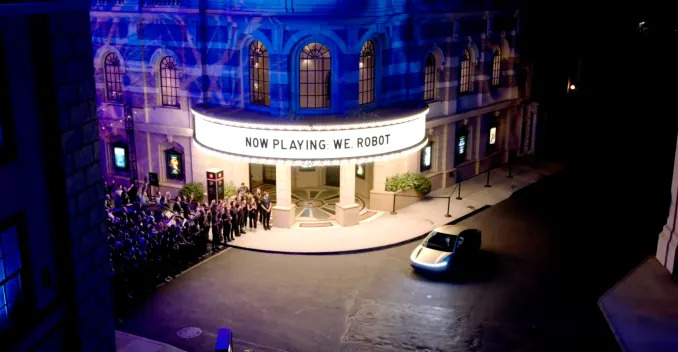
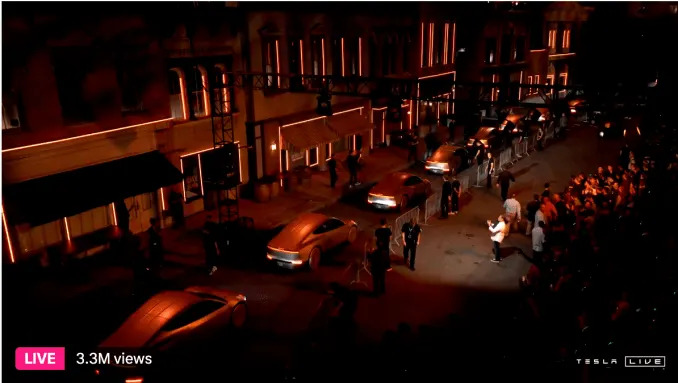

Image Credits:Tesla
Rebecca Bellan
TECH CRUNCH
Thu, October 10, 2024
Tesla has finally revealed its Cybercab, and it looks like a smaller, sleeker, two-seater Cybertruck. And while many were expecting there to be at least one prototype of a robotaxi with no steering wheel or pedals, Tesla CEO Elon Musk delighted his fans with a lineup of 20 vehicles.
The flashy “We, Robot” event took place at Warner Bros. Discovery studio on Thursday. Before walking on stage, Musk walked over to a robotaxi, which opened its gullwing doors, and did a short demo around the well-maintained streets of the Hollywood studio.
Musk repeated previous claims that the cost of autonomous transport will be so low, it will be akin to "individualized mass transit." He said he believed the average operating cost of the Cybercab will be over time around $0.20 per mile.
"And you will be able to buy one," Musk said, adding that the cost of the vehicle would be below $30,000.
Musk also noted he expects Tesla to start doing "unsupervised FSD in Texas and California next year" with the Model 3 and Model Y. He acknowledged that he's too optimistic about timelines, but said he expects the Cybercab to be in production by 2026 or "before 2027."
Fans cheered when Musk said they would be able to test out the Cybercabs themselves at the event.
"They have like 20 of them driving around the entire lot totally unsupervised," one event-goer told TechCrunch.
The robotaxi also doesn't have a plug in charger, and instead has "inductive charging," which is a sort of wireless charging, according to Musk.
Robovan and Optimus
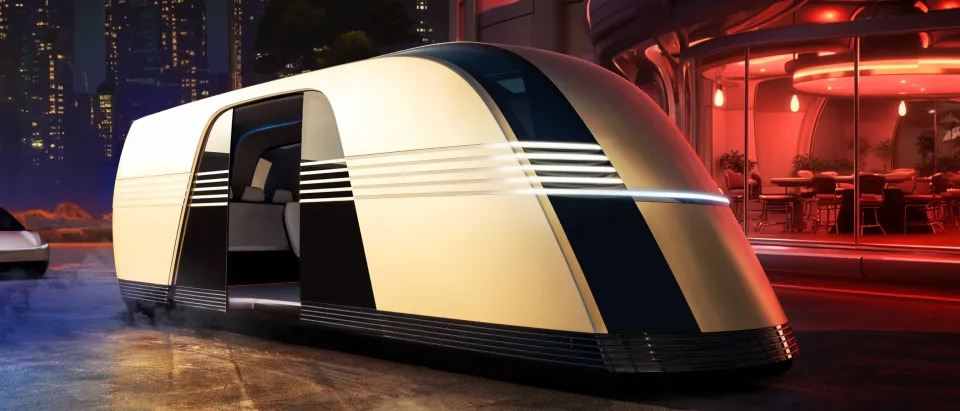 Image Credits:Tesla
Image Credits:Tesla
Tesla unveiled a surprise Robovan at the event, a sleek-looking autonomous bus that can carry up to 20 people and also transport goods. No timelines were revealed for this vehicle — only a hand-waving of a future that could "change the look of the roads."
Musk also introduced roughly a dozen Optimus humanoid robots, sharing his vision for a future where robots act as friend and helper for the low price of around $20,000 to $30,000. Those bots were walking among the humans at the event, dancing like go-go dancers, and even mixing drinks.
They also appeared to be speaking to the guests, and could do different accents and voice personas on command. Though it's not clear whether those capabilities, and the bots' movements, were being remote controlled by a human.
Robotaxi history and context
Thu, October 10, 2024
Tesla has finally revealed its Cybercab, and it looks like a smaller, sleeker, two-seater Cybertruck. And while many were expecting there to be at least one prototype of a robotaxi with no steering wheel or pedals, Tesla CEO Elon Musk delighted his fans with a lineup of 20 vehicles.
The flashy “We, Robot” event took place at Warner Bros. Discovery studio on Thursday. Before walking on stage, Musk walked over to a robotaxi, which opened its gullwing doors, and did a short demo around the well-maintained streets of the Hollywood studio.
Musk repeated previous claims that the cost of autonomous transport will be so low, it will be akin to "individualized mass transit." He said he believed the average operating cost of the Cybercab will be over time around $0.20 per mile.
"And you will be able to buy one," Musk said, adding that the cost of the vehicle would be below $30,000.
Musk also noted he expects Tesla to start doing "unsupervised FSD in Texas and California next year" with the Model 3 and Model Y. He acknowledged that he's too optimistic about timelines, but said he expects the Cybercab to be in production by 2026 or "before 2027."
Fans cheered when Musk said they would be able to test out the Cybercabs themselves at the event.
"They have like 20 of them driving around the entire lot totally unsupervised," one event-goer told TechCrunch.
The robotaxi also doesn't have a plug in charger, and instead has "inductive charging," which is a sort of wireless charging, according to Musk.
Robovan and Optimus
 Image Credits:Tesla
Image Credits:TeslaTesla unveiled a surprise Robovan at the event, a sleek-looking autonomous bus that can carry up to 20 people and also transport goods. No timelines were revealed for this vehicle — only a hand-waving of a future that could "change the look of the roads."
Musk also introduced roughly a dozen Optimus humanoid robots, sharing his vision for a future where robots act as friend and helper for the low price of around $20,000 to $30,000. Those bots were walking among the humans at the event, dancing like go-go dancers, and even mixing drinks.
They also appeared to be speaking to the guests, and could do different accents and voice personas on command. Though it's not clear whether those capabilities, and the bots' movements, were being remote controlled by a human.
Robotaxi history and context

Image Credits:Tesla
Tesla was originally slated to reveal its Robotaxi or Cybercab in August, but delayed the unveiling after the executive requested an “important design change to the front.”
The Robotaxi unveiling is part of Tesla’s push to go “balls to the wall for autonomy” this year after pivoting from prioritizing the production of a $25,000 EV and laying off 10% of staff, including most of the charging team. But Musk’s vision of an autonomous driving future has been in play for years, and a large part of the reason why investors price Tesla’s stock not as an automaker, but as a technology company.
The Cybercab prototype represents one half of the business concept Musk has set forth since at least 2019, wherein the automaker would run its own fleet of dedicated robotaxis on a Tesla ride-hail app, which Tesla teased during its first quarter investor call.
Musk has described the other half of the strategy as similar to Uber or Airbnb, where Tesla owners will be able to add their properly equipped vehicles to Tesla’s ride-hailing app to make extra money when the cars are not in use, and Tesla will take 25% to 30% of the revenue (similar to Apple’s App Store take rate). Musk also said that Tesla projected that robotaxi rides would cost less than public transportation, but he didn’t say by when.
“By the middle of next year, we’ll have over a million Tesla cars on the road with Full Self-Driving hardware, feature complete, at a reliability level that we would consider that no one needs to pay attention, meaning you could go to sleep,” Musk said at Tesla’s 2019 Autonomy Day. “From our standpoint, if you fast forward a year, maybe a year and three months, but next year for sure, we will have over a million robotaxis on the road. The fleet wakes up with an over the air update. That’s all it takes.” That, of course, didn't happen by 2020.
Tesla’s Full Self-Driving software, which is on hundreds of thousands of vehicles today, relies only on cameras to perceive the environment around it. Industry experts say this vision-only approach is the reason why the software is still not actually fully self-driving, despite its name. FSD can perform many automated driving tasks, but still requires a human behind the wheel to stay attentive and take over if needed.
Tesla was originally slated to reveal its Robotaxi or Cybercab in August, but delayed the unveiling after the executive requested an “important design change to the front.”
The Robotaxi unveiling is part of Tesla’s push to go “balls to the wall for autonomy” this year after pivoting from prioritizing the production of a $25,000 EV and laying off 10% of staff, including most of the charging team. But Musk’s vision of an autonomous driving future has been in play for years, and a large part of the reason why investors price Tesla’s stock not as an automaker, but as a technology company.
The Cybercab prototype represents one half of the business concept Musk has set forth since at least 2019, wherein the automaker would run its own fleet of dedicated robotaxis on a Tesla ride-hail app, which Tesla teased during its first quarter investor call.
Musk has described the other half of the strategy as similar to Uber or Airbnb, where Tesla owners will be able to add their properly equipped vehicles to Tesla’s ride-hailing app to make extra money when the cars are not in use, and Tesla will take 25% to 30% of the revenue (similar to Apple’s App Store take rate). Musk also said that Tesla projected that robotaxi rides would cost less than public transportation, but he didn’t say by when.
“By the middle of next year, we’ll have over a million Tesla cars on the road with Full Self-Driving hardware, feature complete, at a reliability level that we would consider that no one needs to pay attention, meaning you could go to sleep,” Musk said at Tesla’s 2019 Autonomy Day. “From our standpoint, if you fast forward a year, maybe a year and three months, but next year for sure, we will have over a million robotaxis on the road. The fleet wakes up with an over the air update. That’s all it takes.” That, of course, didn't happen by 2020.
Tesla’s Full Self-Driving software, which is on hundreds of thousands of vehicles today, relies only on cameras to perceive the environment around it. Industry experts say this vision-only approach is the reason why the software is still not actually fully self-driving, despite its name. FSD can perform many automated driving tasks, but still requires a human behind the wheel to stay attentive and take over if needed.

Lineup of 20 Cybercabs at Tesla's 'We, Robot' eventImage Credits:Tesla
It’s also not clear that existing Teslas even have the right hardware to get to this full self-driving future that Musk has been promising for years. As Musk posted on X in July, the roughly 5x increase in parameter count needed to power Tesla’s next-gen AI “is very difficult to achieve without upgrading the vehicle inference computer.”
Regardless, if Tesla wants to commercialize Level 4 autonomous driving – which means the vehicle can drive itself under certain conditions without needing a human to take over – it will need to prove the safety case. Tesla has been under numerous federal investigations for fatal crashes that happened while Autopilot, Tesla’s lower level advanced driver assistance system, was in place. California has the most rigorous permitting process for testing and deployment of autonomous vehicles, but in most other states, Tesla would have to show at a minimum that its vehicles are capable of pulling themselves over safely.
Then there’s the matter of the Cybercab’s lack of steering wheels or pedals, which would put it out of compliance with federal vehicle safety laws. GM’s Cruise had previously tried to bring its purpose-built robotaxi, the Origin, to production, but failed to gain the necessary approvals from the National Highway Traffic and Safety Administration before scrapping the project.
It’s also not clear that existing Teslas even have the right hardware to get to this full self-driving future that Musk has been promising for years. As Musk posted on X in July, the roughly 5x increase in parameter count needed to power Tesla’s next-gen AI “is very difficult to achieve without upgrading the vehicle inference computer.”
Regardless, if Tesla wants to commercialize Level 4 autonomous driving – which means the vehicle can drive itself under certain conditions without needing a human to take over – it will need to prove the safety case. Tesla has been under numerous federal investigations for fatal crashes that happened while Autopilot, Tesla’s lower level advanced driver assistance system, was in place. California has the most rigorous permitting process for testing and deployment of autonomous vehicles, but in most other states, Tesla would have to show at a minimum that its vehicles are capable of pulling themselves over safely.
Then there’s the matter of the Cybercab’s lack of steering wheels or pedals, which would put it out of compliance with federal vehicle safety laws. GM’s Cruise had previously tried to bring its purpose-built robotaxi, the Origin, to production, but failed to gain the necessary approvals from the National Highway Traffic and Safety Administration before scrapping the project.
No comments:
Post a Comment